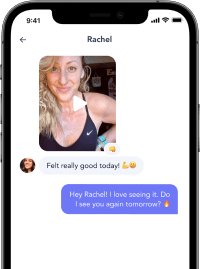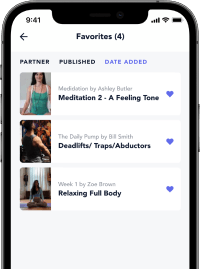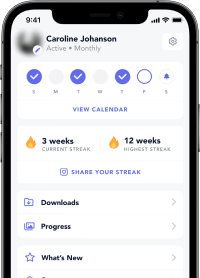
Daily Swims 1K-1.5K
with Brent Hayden
These workouts are for those who want short but effective workouts. Whether you are pressed for time, or are a beginner working to build up their base, these daily swims will help you get the most out of a short distance.

ONLY AVAILABLE ON THE PLAYBOOK APP
Sessions (10)
5/5
0
30 min
0/5
0
35 min
0/5
0
35 min
5/5
1
40 min
5/5
1
40 min
+5 sessions more
Details
Category
Cardio, Functional, Sports
Level
Beginner
Location
Outdoor
Frequently Asked Questions
Who is this for?
Beginners
Anyone kind of swimmer who needs to get an effective swim workout in a short amount of time
Why do you ask for HR instead of RPE?
Because it depends on what I want you to focus on. I like to use HR as a general measure to make sure that you are in the desired training zone (usually Zone 3 or Zone 4). By focusing on HR rather than RPE, it also allows you to focus on swimming as fast as you can but within that specific HR zone. So in order to swim faster, without your HR increasing, you are forced to focus on areas of your swim beyond just effort alone such as your technique and overall efficiency.
Why do you use "Rest" instead of a set interval?
Due to the varying levels of swimmers using our program, it is impossible to write workouts with singular interval times that are going to be suitable for everyone. So I've chosen rest times (either Rest Interval / RI, or Rest Pace / RP) that will give you how much rest you need to hit your training zones just like an interval would.
What is RI and RT?
RI stands for "Rest Interval".
RT stands for "Rest Time"
RI example:
8 x 50m on :15 RI
On your first 50m, if your time was :35, then with 15 seconds RI your interval for the set is :50, so for the duration of the set you are going to hold an interval of :55 even if you fatigue and begin swimming slower. So if on #6 you swim the 50m in :40 sec, your interval is still :50 sec based on your first 50m.
RT Example:
8 x 50m on :15 RT
No matter what time you swim, you will always take 15 seconds rest. If you swim the first 50m in :35 sec, with :15 RP you will push off again when the clock hits :50 sec. If on #6 you swim in :45 sec, you still take 15 seconds rest so you will leave again when the clock hits :55 sec.
What is Desc?
May be written as "Desc"
Gradually increase your speed as required.
Example 1:
4 x 100m Desc 25's
This means you are going begin each 100 with the same starting speed and gradually increase your speed for each 25m inside each 100m.
Example 2:
8 x 50m Desc 1 - 4 on :15 Rest
This means slightly increase the speed you swim each 50, and then repeat until you've swam the number of required 50's, which in this case would be 2 rounds.
What is Rev Desc?
May be written as "Rev Desc".
This is the opposite of a "Descend". I want you to start at your fastest pace, and then gradually decrease your speed as required.
What is N/S?
May be written as "N/S".
This means you need to swim the second half faster than the first half. Keep in mind, this does not mean you swim the first half easy and the second half fast. If that's what I wanted you to do, then I would write that. To negative split well, the difference should be within a few seconds.
Example
200m Free N/S
1st 100m: 1:17
2nd 200m: 1:15
What is E/S?
May be written as "E/S".
This means swimming the first half and second half of a given distance in the same time. Pick a pace that challenges you to maintain the same pace as you fatigue.
What is P and PB?
P stands for Pull
PB stands for Pull Buoy
Swimming with arms only while holding a Pull Buoy between your thighs. I personally don't like holding the Pull Buoy between the ankles or using bands around the ankles because I think it an unnatural cadence to the stroke yielding unwanted technique that can translate to your full stroke.
PB stands for Pull Buoy
What is K and KB?
K stands for Kick
KB stands for Kickboard
Kick is a swimming exercise where you are only using your legs. Unless otherwise specified, this is flutter kick using a kickboard.
What is "Catch Up"?
This is a drill where the catch does not occur until the recovery arm has entered the water beside the opposite arm. Pause for a brief moment with both arms in "11" position, or in other words, extended slightly inside shoulder width apart, but never with hands on top of each other. Keep arms long but not locked. Elbows should continue to be pointing to the outside of the pool until the catch is initiated.
What does B2, B3, B4, etc mean?
This means there is a breathing pattern I want you to follow. The "B" means "Breathing" and the number following is the number of stroke cycles per breath. So B2 means "Breathing every 2", B3 means "Breathing every 3", and so on.
What is TGR?
To Get Ready
This means to use the set to prepare for the upcoming main set. You're already physically warmed up but if you need anything extra to "feel ready", or need an easy float to mentally prepare / clear your head, or both, it's up to you. Just do whatever you need in the distance indicated.
Do I need to swim the TGR continuously?
No. You can break the TGR down however you want. If the set is 100m TGR, you can do it as 4 x 25, 2 x 50, 50 Kick / 50 Swim... whatever you need.
What is the workouts are too hard?
Think of these workouts more like a guide or a goal to achieve. They are not set in stone. It is perfectly normal even for Olympians to adjust their workouts as needed. If you need more rest, take more rest. If there are too many sets, then reduce the number of sets. For example, if 8 x 50m is too much, do 4 x or 6 x 50 instead. If you need more, then add more, or move up to the "Daily Swims 3k - 4k" workouts.
How do I calculate my Max HR (Max Heart Rate)?
The simplest formula is...
220 - (your age) = Max HR
For example, if you are 39 (like me!) your max Heart Rate is 181 BPM
If you are over 40, a more accurate formula would be:
207 - (0.7 x your age) = Max HR
For example, if you are 42, your max HR is 178 BPM
*Women generally have a heart rate that is 5 - 10 BPM higher than men so add 5 - 10 to your answer.
Why do you use HR instead of RPE?
Because it depends on what I want you to focus on. I like to use HR as a general measure to make sure that you are in the desired training zone (usually Zone 3 or Zone 4). By focusing on HR rather than RPE, it also allows you to focus on swimming as fast as you can but within that specific HR zone. So in order to swim faster, without your HR increasing, you are forced to focus on areas of your swim beyond just effort alone such as your technique and overall efficiency.
What is RPE?
RPE is Rate Of Perceived Exertion.
Or in other words...your effort level.
For simplicity we use a standard 0 - 10 scale with 10 being the absolute max effort. You can also think of these like a percentage of effort where a 7 RPE is 70% effort.
Frequently Asked Questions
Who is this for?
Beginners
Anyone kind of swimmer who needs to get an effective swim workout in a short amount of time
Why do you ask for HR instead of RPE?
Because it depends on what I want you to focus on. I like to use HR as a general measure to make sure that you are in the desired training zone (usually Zone 3 or Zone 4). By focusing on HR rather than RPE, it also allows you to focus on swimming as fast as you can but within that specific HR zone. So in order to swim faster, without your HR increasing, you are forced to focus on areas of your swim beyond just effort alone such as your technique and overall efficiency.
Why do you use "Rest" instead of a set interval?
Due to the varying levels of swimmers using our program, it is impossible to write workouts with singular interval times that are going to be suitable for everyone. So I've chosen rest times (either Rest Interval / RI, or Rest Pace / RP) that will give you how much rest you need to hit your training zones just like an interval would.
What is RI and RT?
RI stands for "Rest Interval".
RT stands for "Rest Time"
RI example:
8 x 50m on :15 RI
On your first 50m, if your time was :35, then with 15 seconds RI your interval for the set is :50, so for the duration of the set you are going to hold an interval of :55 even if you fatigue and begin swimming slower. So if on #6 you swim the 50m in :40 sec, your interval is still :50 sec based on your first 50m.
RT Example:
8 x 50m on :15 RT
No matter what time you swim, you will always take 15 seconds rest. If you swim the first 50m in :35 sec, with :15 RP you will push off again when the clock hits :50 sec. If on #6 you swim in :45 sec, you still take 15 seconds rest so you will leave again when the clock hits :55 sec.
What is Desc?
May be written as "Desc"
Gradually increase your speed as required.
Example 1:
4 x 100m Desc 25's
This means you are going begin each 100 with the same starting speed and gradually increase your speed for each 25m inside each 100m.
Example 2:
8 x 50m Desc 1 - 4 on :15 Rest
This means slightly increase the speed you swim each 50, and then repeat until you've swam the number of required 50's, which in this case would be 2 rounds.
What is Rev Desc?
May be written as "Rev Desc".
This is the opposite of a "Descend". I want you to start at your fastest pace, and then gradually decrease your speed as required.
What is N/S?
May be written as "N/S".
This means you need to swim the second half faster than the first half. Keep in mind, this does not mean you swim the first half easy and the second half fast. If that's what I wanted you to do, then I would write that. To negative split well, the difference should be within a few seconds.
Example
200m Free N/S
1st 100m: 1:17
2nd 200m: 1:15
What is E/S?
May be written as "E/S".
This means swimming the first half and second half of a given distance in the same time. Pick a pace that challenges you to maintain the same pace as you fatigue.
What is P and PB?
P stands for Pull
PB stands for Pull Buoy
Swimming with arms only while holding a Pull Buoy between your thighs. I personally don't like holding the Pull Buoy between the ankles or using bands around the ankles because I think it an unnatural cadence to the stroke yielding unwanted technique that can translate to your full stroke.
PB stands for Pull Buoy
What is K and KB?
K stands for Kick
KB stands for Kickboard
Kick is a swimming exercise where you are only using your legs. Unless otherwise specified, this is flutter kick using a kickboard.
What is "Catch Up"?
This is a drill where the catch does not occur until the recovery arm has entered the water beside the opposite arm. Pause for a brief moment with both arms in "11" position, or in other words, extended slightly inside shoulder width apart, but never with hands on top of each other. Keep arms long but not locked. Elbows should continue to be pointing to the outside of the pool until the catch is initiated.
What does B2, B3, B4, etc mean?
This means there is a breathing pattern I want you to follow. The "B" means "Breathing" and the number following is the number of stroke cycles per breath. So B2 means "Breathing every 2", B3 means "Breathing every 3", and so on.
What is TGR?
To Get Ready
This means to use the set to prepare for the upcoming main set. You're already physically warmed up but if you need anything extra to "feel ready", or need an easy float to mentally prepare / clear your head, or both, it's up to you. Just do whatever you need in the distance indicated.
Do I need to swim the TGR continuously?
No. You can break the TGR down however you want. If the set is 100m TGR, you can do it as 4 x 25, 2 x 50, 50 Kick / 50 Swim... whatever you need.
What is the workouts are too hard?
Think of these workouts more like a guide or a goal to achieve. They are not set in stone. It is perfectly normal even for Olympians to adjust their workouts as needed. If you need more rest, take more rest. If there are too many sets, then reduce the number of sets. For example, if 8 x 50m is too much, do 4 x or 6 x 50 instead. If you need more, then add more, or move up to the "Daily Swims 3k - 4k" workouts.
How do I calculate my Max HR (Max Heart Rate)?
The simplest formula is...
220 - (your age) = Max HR
For example, if you are 39 (like me!) your max Heart Rate is 181 BPM
If you are over 40, a more accurate formula would be:
207 - (0.7 x your age) = Max HR
For example, if you are 42, your max HR is 178 BPM
*Women generally have a heart rate that is 5 - 10 BPM higher than men so add 5 - 10 to your answer.
Why do you use HR instead of RPE?
Because it depends on what I want you to focus on. I like to use HR as a general measure to make sure that you are in the desired training zone (usually Zone 3 or Zone 4). By focusing on HR rather than RPE, it also allows you to focus on swimming as fast as you can but within that specific HR zone. So in order to swim faster, without your HR increasing, you are forced to focus on areas of your swim beyond just effort alone such as your technique and overall efficiency.
What is RPE?
RPE is Rate Of Perceived Exertion.
Or in other words...your effort level.
For simplicity we use a standard 0 - 10 scale with 10 being the absolute max effort. You can also think of these like a percentage of effort where a 7 RPE is 70% effort.
Features that support your success

Chat
Tell me your struggles, share your progress, request content and guidance. I'm here for you!

Favorites
Save your favorite content so it's effortless to refer back to. Build a library that serves your goals.

Streaks
Track your progress with streaks to keep yourself accountable. See how many weeks in a row you can get.

Streaming
Stream to your TV and laptop using Apple TV, Chromecast, Roku or Fire TV.

Chat
Tell me your struggles, share your progress, request content and guidance. I'm here for you!
Comments
J
Jake • 8mo ago
Great way to start the morning with good cardio
O
Ondřej • 9mo ago
Smart training but effective!
J
John • 10mo ago
Wanted to let you know (assuming my math is right and I understood the workout correctly ) that this is only 1300m not 1400.
